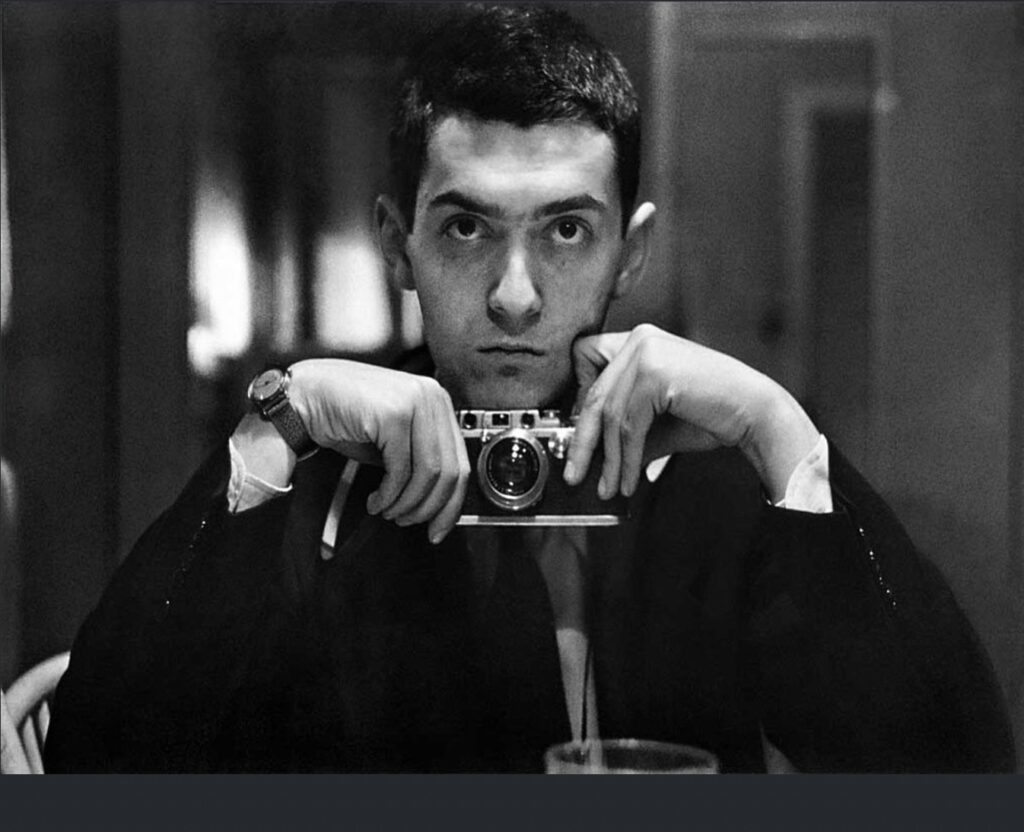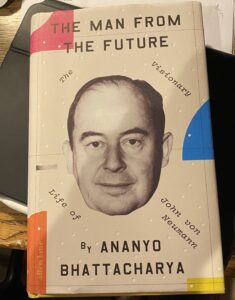Portrait of the Director as a Young Photographer

Random discovery: if you do an image search for “Self-portrait with Leica” you get a lot of images. It’s not surprising, I suppose, given that Leica cameras were the working tools of many celebrated photographers.
This, for example, is one of Stanley Kubrick’s selfies. He was a talented photographer before he became a movie director.
Quote of the Day
.”I’d like to kick the habit of writing books, at least for a while. If there were a detox unit or an analog to the nicotine patch for serial offenders, I think I would sign up for treatment. My habit has already cost me more precious time than I care to admit. The problem with book writing and other addictions is that the resolve to quit is greatest during withdrawal, but as the painful symptoms recede, the craving is apt to return.”
- James C. Scott, in the foreword to Seeing Like a State: How Certain Schemes to Improve the Human Condition Have Failed.
Musical alternative to the morning’s radio news
Brian Eno | An Ending (Ascent)
According to MusicRadar, this was originally recorded for a documentary on the Apollo moon missions entitled For All Mankind. An Ending was taken from Eno’s 1983 studio album Apollo: Atmospheres and Soundtracks and was written by Eno alongside production from his brother Roger and long time collaborator Daniel Lanois.
Long Read of the Day
The genius of John Von Neumann

I’m reading Ananyo Bhattacharya’s fine biography at the moment and have been collecting interesting reviews of it.
This is one of them.
At 17, still at high school, he partly rescued Cantor’s set theory, the basis of much mathematical theory, from a crippling paradox. A couple of years later, he helped reconcile Werner Heisenberg and Erwin Schrödinger’s rival models of quantum mechanics. In the early Thirties, he met the astronomer Subrahmanyan Chandrasekhar, and worked with him on general relativity and the behaviour of stellar clusters. Chandrasekhar would later tell an interviewer, “If I say, ‘He reminds me of von Neumann,’ that’s about the best compliment I can give anyone.”
Von Neumamm read some Alan Turing research which imagined a hypothetical computing machine, and saw how to build a working computer. The paper he produced building on Turing’s ideas is considered “the birth certificate of modern computers”, according to the computer scientist Wolfgang Coy. With his wife Kläri, and Ulam, he pioneered Monte Carlo simulations, vital now in climate modelling and a million other fields.
Astonishing man. Even those whom we traditionally regard as geniuses thought he was smarter than they were.
Apple changes its mind about the right to repair
This is big news, at least to people who live in the Apple ecosystem.
Early next year, a previously impossible repair will be possible: you can buy an iPhone screen directly from Apple, use Apple’s repair guide (and tools, if you want) to install it, and have it fully work as intended, using Apple’s diagnostic software. And you won’t have to own an authorized repair shop to do it.
What makes this surprising is that Apple always maintained that letting consumers fix their own stuff would be dangerous, both for them and for the kit. Now, though, the company has discovered a new interest in letting people fix the things they own.
Starting in early 2022, Apple will sell parts and tools for the iPhone 12 and 13 including the display, battery, and camera to individuals in the US. Apple intends to expand the program to more complicated iPhone repairs and to M1 MacBooks later in the year. You’ll be able to buy parts and tools through the ‘Self Service Repair Online Store,’ where you’ll also have access to service manuals and some version of their repair-enabling software.
This is good for the environment, at least. But I wonder if it has anything to do with the renewed interest of regulators in Apple’s monopoly control of its ecosystem?
Which reminds me — I need to order the tools I need to revitalise my Classic iPod.
Let’s Not Consign Journalistic Transparency to the Memory Hole
Very interesting Politico column by Jack Shafer on how newspaper should correct previous stories when they find they were mistaken or flawed.
Newspaper proprietors, especially former Washington Post President and Publisher Philip L. Graham, have long subscribed to the idea that their newspaper articles constitute “the first rough draft of history.” Some first rough drafts are more accurate than others, as every journalist will concede. So when reporters uncover new information that undermines earlier copy, they write new stories, updating the record. What they don’t do is go back and erase the original, flawed version. But that’s what the Washington Post did last week.
As Post journalist Paul Farhi reported last Friday, the newspaper removed from its archives two stories from 2017 and 2019 related to the controversial Steele dossier and replaced them with new articles that added and deleted whole sections and also added explanatory text at the top, alerting readers to the changes…
What’s peculiar about the Post’s method of error correction, says Shafer, was its decision to vaporise the two original stories. They can’t be retrieved from LexisNexis, as the Post left that database in late 2020. Apparently the deleted pages can be found on Factiva, a Dow Jones subscription database that costs about $249 a month, which makes it expensive for readers who can’t afford the service to determine precisely what the paper’s first rough draft got wrong and how it was amended.
Such heavy reworking of years-old copy is so rare it approaches the unprecedented, as American University media history professor W. Joseph Campbell told Farhi. Stephen Bates, a professor of journalism at the University of Nevada at Las Vegas, concurs. “It’s hard to have a paper of record if the record keeps changing,” Bates says.
Surely the ‘first draft of history’ should stand, along with the updated correction, even if its presence is embarrassing for the publication that originally ran it.
My commonplace booklet
Caroline O’Donoghue: How I imagine an annual performance review with the dog would go
Hello, dog. Please take a seat. I’m so glad we could find time for this little chat.
Are you… Ok, you’re still sitting down.
So to begin… Still sitting down. Right. Maybe the tight circular movements can wait until after our annual performance review, and you can just stand for the meantime.
I know you only do the little circle movements when you’re anxious. I also know why you are anxious. You have sensed, correctly I think, that there has been a certain level of disharmony among the senior members of staff (me and Gavin) and much of that unhappiness has stemmed from our disappointment in your most recent work.
This Blog is also available as a daily email. If you think that might suit you better, why not subscribe? One email a day, Monday through Friday, delivered to your inbox. It’s free, and you can always unsubscribe if you conclude your inbox is full enough already!
